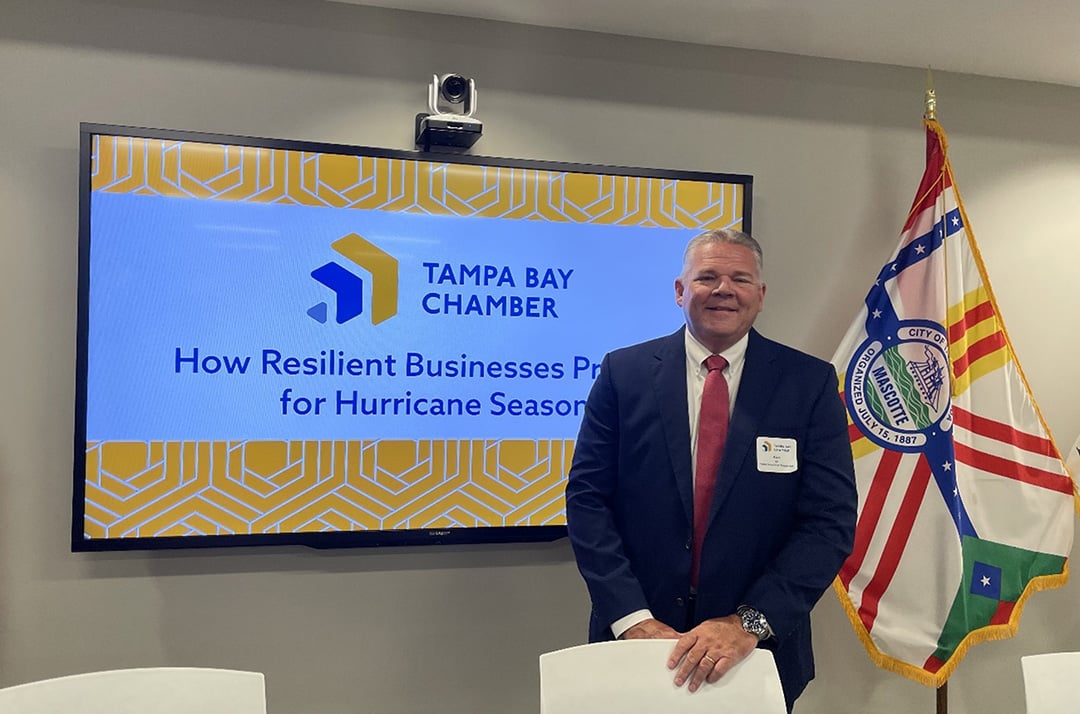
Few things strike fear in the heart of business owners like hurricane season. The hazards are endless – flooding, wind damage, lightning, waterspouts, tornadoes and economic injury to name a few. What can you do to ensure your business and your employees bounce back after a storm?
PREPARE!
Tampa Electric’s Director of Corporate Security and Emergency Management, Alan Hill, recently participated in Tampa Bay Chamber of Commerce’s “How Resilient Businesses Prepare for Hurricane Season” session as a guest panelist with other emergency management leaders from the Tampa Bay area. Their advice was clear:
A well-tested emergency plan with proven communication tactics is essential to business continuity after a storm or other crisis.
What is an emergency plan?
An emergency plan outlines the procedures, tasks and communications your business and employees will follow before, during and after severe weather – or any crisis. The goal of this plan is to minimize the threat’s impact and ensure business continuity, safety, asset protection and a speedy physical and economic recovery.
Why should your business develop an emergency plan?
There are numerous benefits to having an emergency plan. Storms and other hazards are inevitable. Creating, testing and refining an emergency plan ensures your business, stakeholders and employees experience a fast and successful recovery from whatever Mother Nature sends our way. With an emergency plan, you’ll also have an easier time raising recovery capital, building trust with your customers and stakeholders and reducing physical and economic losses. Additional benefits include improved safety, minimal operational disruption, proper resource allocation, regulatory compliance and financial savings.
How do you develop a strategic emergency plan?
The Chamber’s emergency management panel said, “the devil is in the details!” Your emergency plan should be fluid, tested and continually updated. Chaos is an opportunity for improvement. To create a plan that will help your business survive and thrive, the panel recommended:
- Assessing your business risks and vulnerabilities.
- Ask yourself pointed questions like “what if” and “how will we.”
- Research, review and use lessons learned from past experiences.
- Examine your facility and local infrastructure for potential wind and water intrusion.
- Thinking through the recovery process.
- How will you communicate with your team?
- How will you scale up after a storm?
- What resources will employees need to work after a storm?
- Where will your business go if your current location is not useable?
- Reviewing your supplier arrangements.
- What can you do if your suppliers can’t deliver?
- Where do you fall in your supplier’s priority list?
- Do your suppliers have a continuity plan?
- Do you have alternate suppliers you can use?
- Involving your employees in plan development.
- Gathering and protecting your financial information and other documents from potential damage or loss.
- Debriefing after testing and surviving real and mock storms to refine your plan.
How can your business ensure a successful recovery?
The emergency management panelist provided a treasure trove of ideas based on their storm experiences to help your plan succeed. Below is a sampling of their sage advice.
- Stay calm and maintain composure.
- Update your employee contact information.
- Keep key stakeholders updated about your status and plan.
- Establish an emergency alert system or call tree for communications.
- Establish employee check-in points.
- Obtain back-up communication systems like 2-way radios, satellite phones, text messaging or communication apps.
- Establish an emergency fund and create reserves for economic loss from a storm.
- Document your assets before a storm and any post-storm damage with pictures or videos.
- Meet with your insurance company before a storm to walk through potential hazards and ensure proper coverage for both physical and economic assets and losses.
- Categorize storm expenses by type for tax purposes and insurance reimbursements.
- Allow your employees to take care of their personal needs first. Then they will be more available to help your business without worrying about home.
- Cross train employees in case someone cannot return after the storm.
What resources are available to help create an emergency plan?
To help develop your emergency plan, the panel recommended taking a risk assessment at Ready.gov, familiarizing yourself with Tampa Electric’s Storm Center and Storm Safety webpages, visiting SBA.gov and FEMA.gov, watching the Project Phoenix 2.0 video and following the tips in our storm preparedness checklist, storm reference guide and storm preparedness brochure.
Although we hope that severe weather and other emergencies never come our way, we know preparedness and planning are the best ways to mitigate the damage and inconvenience they can cause. Establishing, testing, communicating and refining your business’s emergency plan will equip you with the tools, knowledge and strategies you and your employees need to face storms head-on, minimize their effects, and emerge stronger than ever.
